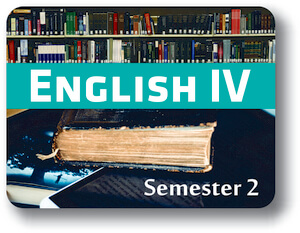The Art of Rhetoric in Lincolns Second Inaugural Addressquiz Active

English language IV - Semester - 2
Recommended Grade Level: 12
Course Credits: 0.v
Class Price: $285.00


Course Details:
English IV focuses on four main topics: Advanced strategies for reading and writing, analysis of foundational U.S. documents, analysis of multiple perspectives, and relating past events to the present. The fine art of effective reading and writing builds on students' fundamental skills to promote critical and active reading, effective writing, and analysis of various texts. The course fabric walks students through diverse foundational U.Due south. documents from the 17th, 18th, and 19th centuries, including The Announcement of Independence, the Constitution, and Lincoln's 2d Countdown Address to help students in evaluating documents of historical and literary significance. Through representations of Earth War Two, D-Day, and Anne Frank's diary, students learn to analyze sequences of events, integrate multiple sources of information, and conduct independent enquiry to answer a question or solve a trouble. Topics such as the Nifty Depression, the Great Recession, multiple outbreaks of plague, the Flu pandemic of 1918, and the COVID-19 pandemic of 2020 provide an opportunity for students to evaluate various documents, infographics, and media files for their historical and literary significance as they chronicle past events to the present.
The broad series of lessons and activities included in this course offers various modalities for ultimate pupil engagement and content retention. Each department contains a serial of lessons that innovate the content, provide examples, and repeated opportunities for students to apply their knowledge. Quizzes, assignments, and writing opportunities also allow students to demonstrate their mastery of the textile.
Syllabus:
Department 1 - The Fine art of Constructive Reading and Writing
The lessons in this section volition aid yous:
- read critically for comprehension
- use avant-garde strategies to improve your writing
- encounter how multimedia enhances content
- learn from brief instructional videos that supplement the lessons
Lessons:
- Introduction to the Dutch Golden Age - Part one
- Introduction to the Dutch Aureate Age - Part two
- Dutch Gilt Age for the Arts - Part 1
- Dutch Golden Age for the Arts - Role 2
- Landscapes in Dutch Golden Age Art
Section two - Analyzing Foundational US Documents
In this section, you lot will learn well-nigh the following objectives:
- Become familiar with foundational U.S. documents from the 17th, 18th, and 19th centuries including The Proclamation of Independence, the Constitution, and Lincoln's Second Inaugural Address.
- Evaluate foundational U.S. documents of historical and literary significance.
- Evaluate the reasoning in seminal U.S. texts.
- Use constitutional principles and legal reasoning.
- Identify bounds, purposes, and arguments in diverse works, such as The Federalist Papers and presidential addresses.
Lessons:
- 17th Century Foundational U.Due south. Documents
- 18th Century Foundational U.South. Documents - Part 1
- 18th Century Foundational U.S. Documents - Office two
- 19th Century Foundational U.S. Documents
- Seminal U.S. Documents
Section 3 - Analyzing Multiple Perspectives
In this section, you lot will learn almost the following objectives:
- Cite strong and thorough textual evidence to support analysis of what the text says explicitly as well equally inferences drawn from the text, including determining where the text leaves matters uncertain.
- Determine ii or more central ideas of a text and analyze their evolution over the course of the text, including how they interact and build on one some other to provide a complex analysis; provide an objective summary of the text.
- Analyze a circuitous set of ideas or sequence of events and explain how specific individuals, ideas, or events collaborate and develop over the grade of the text.
- Determine the meaning of words and phrases as they are used in a text, including figurative, connotative, and technical meanings; analyze how an writer uses and refines the significant of a key term or terms over the form of a text.
- Analyze and evaluate the effectiveness of the structure an author uses in his or her exposition or argument, including whether the construction makes points articulate, convincing, and engaging.
- Make up one's mind an author's betoken of view or purpose in a text in which the rhetoric is particularly effective, analyzing how style and content contribute to the power, persuasiveness, or dazzler of the text.
- Integrate and evaluate multiple sources of information presented in different media or formats equally well as in words to accost a question or solve a problem.
- Evaluate a speaker's point of view, reasoning, and use of evidence and rhetoric, assessing the stance, premises, links among ideas, discussion choice, points of emphasis, and tone used.
- Bear short as well as more sustained research projects to answer a question (including a self-generated question) or solve a problem; narrow or broaden the inquiry when appropriate; synthesize multiple sources on the subject, demonstrating understanding of the subject nether investigation.
- Describe evidence from informational texts to support analysis, reflection, and enquiry.
- Produce clear and coherent writing in which the development, organization, and fashion are advisable to task, purpose, and audience.
- Write arguments to support claims in an analysis of substantive topics or texts, using valid reasoning and relevant and sufficient prove.
- Introduce precise, knowledgeable claim(due south), establish the significance of the claim(s), distinguish the claim(s) from alternate or opposing claims, and create an organization that logically sequences claim(s), counterclaims, reasons, and evidence.
- Develop claim(south) and counterclaims fairly and thoroughly, supplying the most relevant evidence for each while pointing out the strengths and limitations of both in a style that anticipates the audience'southward noesis level, concerns, values, and possible biases.
- Utilize words, phrases, and clauses besides as varied syntax to link the major sections of the text, create cohesion, and clarify the relationships between claim(s) and reasons, between reasons and evidence, and between claim(s) and counterclaims.
- Establish and maintain a formal style and objective tone while attending to the norms and conventions of the discipline in which they are writing.
- Provide a concluding statement or section that follows from and supports the argument presented.
- Write narratives to develop real or imagined experiences or events using constructive technique, well-chosen details, and well-structured consequence sequences.
- Appoint and orient the reader by setting out a trouble, situation, or observation and its significance, establishing one or multiple point(s) of view, and introducing a narrator and/or characters; create a smooth progression of experiences or events.
Lessons:
- Introduction
- Analyzing Multimedia in Informational Text
- Analyzing Images, Multimedia and Oral Presentations
- Analyzing Personal Accounts - Anne Frank
- Analyzing Personal Accounts - High german Soldier
- Writing Arguments to Support Claims
Department four - Relating Past Events with the Present
In this section, you will learn about the following objectives:
- Evaluate various documents, infographics, and media files for historical and literary significance.
- Chronicle by events to present events.
- Gain perspective on information from an era when modern medicine had not yet been built-in.
- Empathize the asymmetric bear on of epidemics and pandemics over time.
- Empathize similarities between past and present epidemics and pandemics.
- Understand the fiscal and economical hardships that humans suffered in the last hundred years.
- Understand the worst man-fabricated ecological disasters of all times in the history of America, the Dust Bowl.
Lessons:
- Epidemics and Pandemics
- The Great Depression and The Grit Bowl
Accreditation & Approvals
Source: https://redcomet.org/english-iv-semester-2/
0 Response to "The Art of Rhetoric in Lincolns Second Inaugural Addressquiz Active"
Postar um comentário